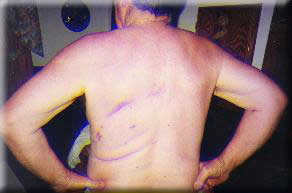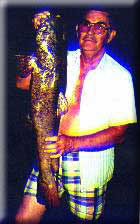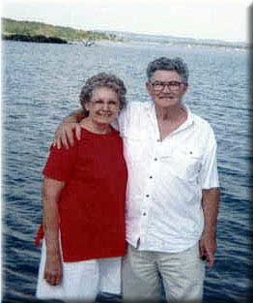68-Year-Old Angler With MM Dangles Several Hooks In The Water
Mr. Charley Baker is a sixty-eight (68) year old retired construction worker, avid square dancer and fisherman who lives in a lake house in Canyon Lake, Texas. Charley loves fishing. If you're lucky, he'll tell you where all the "hot-spots" are for catfish, bass and perch. Charley and his wife Fran like to fish just about everyday. Lately, because Charley has been diagnosed with mesothelioma, he has not been able to enjoy both the solemnity and thrill of fishing. Fran likes to think she's now the big game hunter of the family, but don't count Charley out -- in his words, with a wink, he can still "flip a pole."
The Baker's have always enjoyed cutting their own path, blazing their own trail, following the less traveled highways and bi-ways. They have toured America in their large trailer home. The Bakers have also enjoyed trekking through Africa, Australia, Hawaii, New Zealand, England, Whales, Scotland and Europe. "We have enjoyed life but there's a lot more living we aim to do!" exclaims Fran. The Bakers enjoy visiting far-off places but, to them, there is no greater thrill than returning home to Canyon Lake, Texas. For the Bakers, it's the simple pleasures that make life so enjoyable, like baiting three or four hooks and tossing them over the side and practicing the art of patience.
In July of 1998, the Bakers were traveling through Wyoming when Charley began to have trouble breathing. The Bakers attributed the symptoms to high altitude but when their trailer came down from the pass, the shortness of breath continued. They went to the West park Hospital in Cody, Wyoming, where the doctors took a chest film and noted a left pleural effusion in the lower lobe. The doctors also saw several nodules in the right lung which were consistent with pleural plaques.
The Bakers immediately headed home to Texas. Their family physician ordered a battery of tests, including an additional chest film, CT scan, a sonar test and several blood tests. The doctors removed over 2400 cc's of cloudy yellow fluid. The cytology report favored mesothelioma. The fluid was then sent to a laboratory in New York for a definitive diagnosis.
In the meantime, the Bakers' doctor opined that a surgeon should examine the pleura, remove biopsy tissue and possibly inject talcum powder into the chest to prevent more fluid from accumulating. The Bakers, based on what they knew, thought this was a reasonable course to take.
At the end of July, Mr. Baker underwent a flexible bronchoscopy, left thoracoscopy and a talcum powder pleurodesis of the left pleural cavity. The diagnosis was malignant mesothelioma. Mr. Baker's doctors did not recommend any treatments other than to "wait and see" if any fluid returned. Surgery was ruled out. The doctors only spoke of "palliative" care. No mention of any aggressive course to eradicate or retard the progression of the tumor. The Bakers could not believe that with today's medical technology that a cure was simply out of reach.
Fran Baker decided to "grab the tiger by the tail" and conduct her own research via the Internet. After viewing our website, she learned of Dr. John Costanzi's Onconaseprotocol in Austin, Texas. The Bakers met with Dr. Costanzi in hopes of qualifying. The Onconase trial is a randomized study which compares Onconase versus Doxirubicin. Unfortunately, the Bakers were selected for the Doxirubicin, which they declined.

Charley Baker, post surgery
Fran returned to this website and read about the Phase III Trial Cancer Interaction Study using Bayer 12-9566 at the San Antonio Cancer Research Medical Center (CRMC) in San Antonio, Texas. When she spoke to a representative, she learned of a another clinical trial at the CRMC using the investigational anticancer drug called Ely Lilly LY231514 (Multi-Targeted Antifolate or "ALIMTA (R) (pemetrexed disodium)). Dr. Lisa Hammond is the physician investigator evaluating the study.
When the Bakers consulted with the patient coordinator for ALIMTA, they were asked which doctor referred them to CRMC. Fran told the coordinator they were not referred but learned about the CRMC through this website. According to Fran: "I don't know what we would have done if we had not found Roger Worthington's webpage. It seems to have all the information available in one spot. I do not have to search dozens and dozens of different sites, all I have to do is go to his page and everything I need to know is there, and its current."
Charley's first treatment was on May 18, 1999. In a nutshell, he takes folic acid supplements for two (2) days prior to treatment. He receives more folic acid the morning of the treatment, followed by a ten (10) minute intravenous injection of LY231514 and additional folic acid for two (2) days post-treatment. The folic acid supplements are administered on the day of the treatment. Blood tests are taken after 15 minutes, 30 minutes, 1 hour, 2 hours, 4 hours, 6 hours and 9 hours. Treatment days can last up to ten (10) hours. The folic acid supplements are administered to minimize the toxicity of the drug. Charley's next treatment is scheduled for May 26, 1999.
After his first treatment, Charley's only major side effect was a loss of appetite. He was admittedly "worn out" for the next few days, but his energy level picked up quickly. Charley did suffer a rash that his doctors treated with steroids, but according to Charley, he thought the rash was a result of stress. When I told him to avoid stressful situations, he put his arm around me and with a glint in his eye and whispered: "Have you ever been married?" To paraphrase Mark Twain, no tumor can withstand the assault of laughter!

Charley with one of many catches.
The Bakers are very optimistic about the study. Charley will have a CT scan on May 28, 1999. After his doctors review the scan, they will determine whether Charley will continue in the study. Charley and Fran continue to be hopeful that the tumor will respond.
If the CT scan does not show any improvement, there is a chance Charley may not be invited to continue in the study. The Bakers are prepared for the worst. We alerted the Bakers to the potential availability of a new chemotherapy drug, Platar, which is a liposomal formulation of a novel platinum drug that has low toxicity and was shown to have a "complete pathologic response based on biopsy and cytology in 61% and 73% of 17 pleural mesothelioma patients participating in a phase II study." The phase II trial is ongoing at MD Anderson in Houston, which is only a half-days drive for the Bakers.
Charley and Fran now have a backup plan -- in NASA parlance, a "contingency plan", or in angler parlance, a second baited hook, another line in the water.
Charley is unable to dance anymore. He is also too weak to tend to his trout lines on Canyon Lake, but he WILL continue to fish alongside Fran. And of course he will help fry, bone and consume the lake's precious bounty. Not even mesothelioma can deprive Charley Baker of this one simple pleasure.
We will continue to follow Charley's progress with regular updates.
*** POSTED MAY 27, 1999 ***
Update on Charley from Fran -- 9/22/99
CT Scans since treatments have shown a stabilization of the disease and to us that is good news. If we can only have stabilization, we will be happy. Charley will have another CT Scan Tuesday (September 28) for an update.
Aside from the stabilization, we have noted improvements in that the pain in his left lung has disappeared. He also had severe sweating episodes, which are gone. His breathing is better and he is able to resume a normal life like driving our RV to Dallas recently. He has had numerous other tests, like CT scan of his abdominal area, a colonoscopy and sonograms of his kidneys, bladder and prostate and everything is normal with no masses anywhere.
The doctors and we are convinced that the treatment with LY231514 with Folic Acid Supplementation has helped stabilize the disease. He was diagnosed with Mesothelioma last July and is definitely better now.
The after effects from the drug have been minimal. He had some hair loss but not noticeable. He has two or three down days after treatment but then recovers. They monitor his blood carefully and he has had decreases in white cells but recovers quickly. He has an itchy rash after treatment which is treated with dexamethasone. He will have his seventh treatment on October 5. The folic acid causes him to have a bad taste in his mouth but that passes. He has been known to lose 5 to 7 lbs. after treatment but recovers those lbs. quickly.
He just got through cutting the grass in the back yard on his riding mower and that's good. (gr)
We are making plans for the future and are thinking of buying some property and building a one-story house since we now live in a two-story and we are getting tired of the stairs. A year ago, Charley was struggling a bit to go upstairs but he does much better now.
Best Wishes,
Fran
*** POSTED SEPTEMBER 24, 1999 ***
Update on Charley from Fran -- 10/6/99
Charley was scheduled for a treatment today but has a little problem with his kidneys so it was postponed to next Tuesday. They were not concerned and just told him to drink a lot of liquids. This has happened once before and is caused by the chemo.
Otherwise, he is fine and has quite a bit of energy - enough energy to get a 7 lb. and 5 lb. Blue Catfish off the hook plus 15 crappie last week. As long as he can fish, he is happy as a lark.(gr)
We finally got a copy of the CT Scan results today and wanted to pass the information to you. I will just quote from the radiologist's report: "Diffuse pleural thickening and volume loss in the left hemithorax is stable. Multiple focal calcified and noncalcified plaques on the right are unchanged. No nodules or infiltrates are seen in the lungs. There is no significant mediastinal, hilar or axillary adenopathy. There are no pleural effusions. There is no evidence of chest wall invasion. The abdominal and retroperitoneal organs are normal. No masses or enlarged nodes are seen below the diaphragm. There are no free fluid collections. No destructive skeletal lesions are seen."
The report also states under "IMPRESSIONS: Pleural thickening and volume loss in the left hemithorax and multiple pleural plaques in the right chest are unchanged. No evidence of new or progressive disease".
Like Dr. Hidalgo says, stabilization of the disease is what he is trying to accomplish. We know there is no cure and the asbestos particles can't be removed. So, we are very happy with the stabilization due to LY231514. The plan is to keep Charley on this chemo for a total of a year and then get him off for 3 or 4 months and see what happens.
Best Wishes,
Fran
Update on Charley from Fran -- 3/16/00
The news continues to be good on Charley's condition. He had a CTScan last week and we just got back from seeing the doctor, who gave us the good news that the Radiology Report said his condition continues to be stable and that all internal organs were "unremarkable in appearance".
We were elated by the news and so were all our doctors and everyone at CTRC in San Antonio. Charley was asked to come back in 3 months for further monitoring and if his condition continues to be stabilized, he will then go back in 6 months. Eli Lilly's LY231514 has a winner in Charley. We feel that it's a miracle and we are so grateful to God, the doctors and nurses at CTRC, and all you lovely people for always being so helpful.
We sincerely hope that other mesothelioma patients will be brave and try new treatments. Folks, there is hope!
Fran
*** POSTED MARCH 17, 2000 ***
Letter from Texas Senator Phil Gramm in response to Fran Baker's letter regarding FUNDING FOR MESOTHELIOMA RESEARCH
* * * * *
United States Senate
Washington, D.C.
August 17, 2000
Dear Friends:
Thank you for contacting me in support of funding for mesothelioma research. I am glad to learn of Mr. Baker’s improved condition, and I appreciate having the benefit of your comment on this matter.
The United States simply does not spend enough on basic research and has not done so for more than a generation. In 1965, 5.7 percent of the federal budget was spent on non-defense research and development. Thirty-two years later, that figure had dropped to 2.1 percent. In no years since 1970 has the United States spent as large a percentage of our GDP on non-defense research and development as either Germany or Japan. From 1992 through 1995, for the first time in 25 years, real federal spending on research declined for four straight years.
In response to this troubling situation, I introduced the National Research Investment Act of 1998 (S. 1305) to reverse this trend and increase the total amount authorized for non-defense research and development from $34 billion to $68 billion over a 10 year-period. This bill also included a doubling of funding for the National Institutes of Health from $13.6 billion to $27.2 billion. While my bill did not become law, it helped raise awareness in the Senate about the need to bolster our commitment to basic research. In the current Congress, I have co-sponsored a bill (S. 296) to double federal funding for scientific and medical research over an 11-year period. I am pleased to report that S. 296 passed the Senate by unanimous consent on July 26, 1999, and was referred to the House Committee on Science, where it awaits further review.
Despite President Clinton’s FY2000 budget proposal that included a modest 2.1 percent increase for NIH funding, I am pleased to report that the FY2000 consolidated appropriations act allocated $17.9 billion for NIH funding --$.23 billion more than the President requested. Included in this funding was over $3.3 billion for the National Cancer Institute. I voted for this bill, and I am convinced that our highest hopes and dreams for the 21st century will not be realized if we do not restore the prominence that research and technology once had in the federal budget. If we once again give scientists and researchers the support they deserve and make the same commitment to our children’s future that our parents made to ours, we can expect to achieve great medical and technological breakthroughs that will improve the quality of life for all Americans. Expanding the nation’s commitment to basic research in science and medicine is a critically important investment in the nation’s future, and you may be certain of my commitment to that end.
I understand the personal importance of this issue to you and your family, and you can be sure that I will keep your concerns in mind as funding for cancer research is considered by the Senate for FY2001.
I appreciate having the opportunity to represent you in the United States Senate. Thank you for taking the time to contact me.
Yours respectfully,
Phil Gramm
United States Senator
PG:rtr
*** POSTED OCTOBER 17, 2000 ***
Mr. Charley Baker passed away on February 3, 2001
God looked around his garden
and he saw an empty place.
He then looked down from heaven and saw
your tired face.
He knew that you were suffering.
And a cure was not to be.
So he put his arms around you and whispered
"Come with me."
With tearful eyes we watched you as you
slowly slipped away.
And though we loved you dearly,
we could not make you stay.
Many times we’ve needed you and
many times we've cried.
If only Love could have saved you,
you never would have died.
The Fighter
(for Charley)
by
Marsha Baker Richardson
(daughter of Charley Baker)
As I lie here in the twilight and look back on better days,
He lies in his hospital bed all doped up and in a haze.
He was once a professional boxer all decked out in shiny blue shorts,
And the crowd all loved his punches as he danced around his court.
Though he sometimes lost the battle, he would never throw in the towel.
That was before he met the companies that used the chemicals from Dow.
Though he’s lost the blue satin shorts and the muscles of his youth,
He’s still a fighter even after their abuse.
Now he lies in bed all day and can’t even move an inch,
his torture and pain is here to stay for the Grim Reaper holds the synch.
His eyes are dark and hollow and his legs are merely sticks.
The daily spoon of baby food has Morphine in the mix.
The doctors are all baffled how he’s kept the fight so long,
But his family knows he’s a fighter and looks forward to each dawn.
They have watched the weight melt off him like the men from Hitler’s camp,
But they haven’t the heart to tell him he is going down for the count.
All the while, they curse the companies who have put him in this hell,
Even Hitler outlawed asbestos and the companies knew it as well.
The family gathers round him as the priest reads his last rites,
But the boxer insists he has a few good years and refuses to give up the fight.
His determination makes his daughter cry and she brushes away her tears,
But his wife decides to take on his fight even though it will take years.
It’s a family torn to pieces by the loss of their husband, brother and father . . .
They’d dreamed of him living to a ripe old age like his Papa and his Mother.
As they watch his urine turn bloody pink and his breathing turn heavy and labored,
They wrestle with the choice to stop his heart pills; even though now death is favored.
No one should be put through this pain, especially not one so good,
And when God rings his "fighter’s bell" this man will be where he should.


